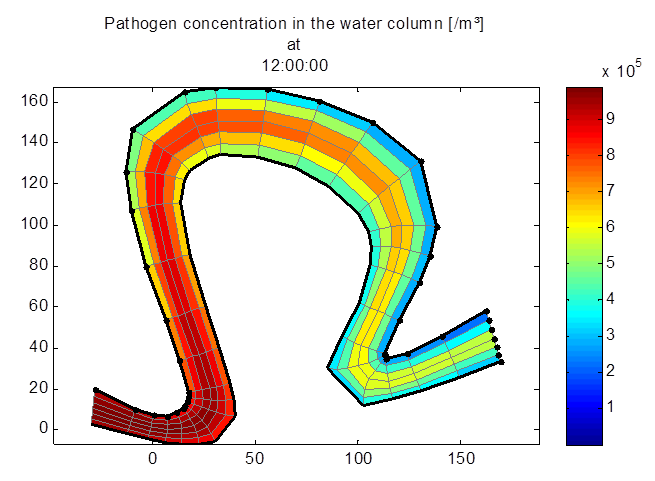Reducing the survival of pathogens in urban water by making optimal use of natural processes
by Carina van der Meer
Introduction
Pathogens are present in our urban water system, and may pose a health risk to swimmers and playing children. Although the knowledge of pathogens has increased over recent years, little is known about their behaviour in the urban water system. The goal of this thesis is to investigate this.
First, the behaviour of pathogens under the influence of environmental variables such as sunlight intensity and temperature was investigated. Then, this was incorporated into a 2D finite element model to simulate the movement of pathogens through a water system
The model
The model setup for one cell is shown in Figure 1.
In- and outflows are generated by a Delft3D model. The remaining processes are modelled in Matlab through post processing.
Three states of the pathogen are considered: those that are free floating in the water column, those that are adsorbed onto a particle in the water column and those that are adsorbed onto a particle in the sediment. Only the pathogens in the water column can move between cells through flow, and only pathogens that are adsorbed to particles are influenced by sedimentation and resuspension.
The pathogen decay was assumed to adhere to equation 1, which was composed based on existing data from literature. The values of the constants were estimated for Faecal Coliforms.


Results
| Three water systems have been examined to test both the model itself and the behaviour of pathogens in such a system. In the first, the influence of channel depth was examined, in the second, the shape of an inflow of pathogens, and last, the influence of natural banks. The removal of pathogens from the water column was found to be caused mostly by the sedimentation and not so much by pathogen decay. The effect of this is that in an equilibrium state, the concentration of pathogens in the sediment is much higher than that in the water column. |
As sedimentation is the largest factor when considering the removal of pathogens from the water column, any measures that decrease the flow velocity decrease pathogen concentrations. However, pathogens are still present in the system, and care should be taken that the water column is not reinfected through resuspension.
Student: C.G. van der Meer
Committee:
- Dr.ir. F.H.M. van de Ven
- Prof.dr.ir. N.C. van de Giesen
- Prof.dr. G.J. Medema
